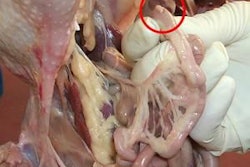
Dr. Andy McRee of Lohmann Animal Health commented on protection of flocks against Pasteurella infection by vaccination. Long regarded as an essential measure in the broiler industry, it is becoming more common to administer Pasteurella vaccine to pullets reared on litter before transfer to a floor laying system.
This is especially the case when producing brown shelled eggs in units previously used to house broiler breeders which may have become infected with P. multocida.
Dr. McRee recommends administration of an inactivated emulsion vaccine at approximately six weeks of age to establish a low level of circulating immunity of relatively short duration directed specifically against the subsequent dose of relatively virulent live attenuated CU strain vaccine. Subject to priming with the inactivated vaccine the live attenuated product can then be administered to pullets at approximately 12 weeks of age with minimal adverse reaction.
This two-phase vaccination program is different to the approach used for viral respiratory infections in which the first vaccine is usually a live attenuated agent to stimulate immunity. Thereafter protection is boosted with an inactivated oil emulsion vaccine. When protecting against pasteurellosis, the first inactivated vaccine establishes sufficient antibody response to prevent morbidity or even mortality when the CU strain is administered by wing web stab.
Providing flock protection
The need to employ good vaccination practices and to monitor “takes” at the point of administration of the wing web stab was stressed by Dr. McRee to ensure that the flock is effectively protected. The live CU strain vaccine will provide protection against all known strains of Pasteurella multocida in contrast to inactivated emulsion vaccines, either commercial or homologous, which are strain specific.
The program of vaccination should be accompanied by strict biosecurity and rodent control since rats and mice can serve as reservoirs of infection. It is also advisable to include an effective vaccine against E.Coli in the pullet vaccination program since septicemia can occur concurrently with pasteurellosis as a result of contaminated housing, immunosuppression or stress.
















